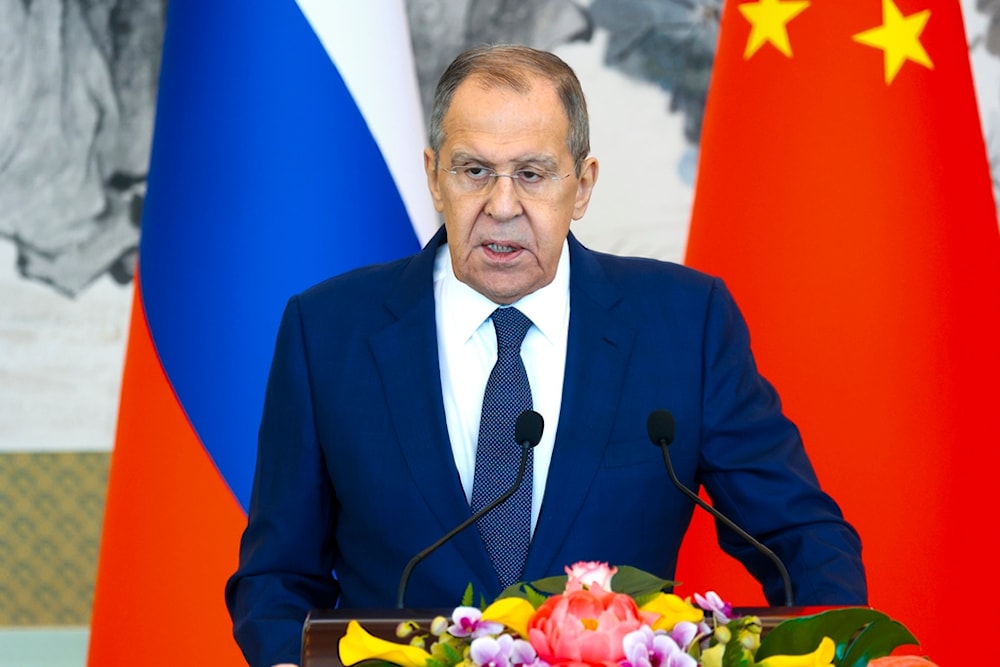Russia, China reach near complete de-dollarization in bilateral trade
Lavrov cited the resilience of Russian-Chinese trade and economic cooperation for this development despite facing challenges from Western states.
-

In this photo released by Russian Foreign Ministry Press Service on Tuesday, April 9, 2024, Russian Foreign Minister Sergey Lavrov speaks to the media during his and Chinese Foreign Minister Wang Yi's joint news conference following the talks in Beijing, China (AP)
During a gathering of the Council of Heads of Russian regions under the Foreign Ministry on Monday, Russian Foreign Minister Sergey Lavrov said that Russia and China have significantly reduced their reliance on the dollar in business transactions, opting for national currencies in over 90% of mutual payments.
Lavrov cited the resilience of Russian-Chinese trade and economic cooperation for this development despite facing challenges from Western states.
"Russian-Chinese trade and economic cooperation are actively developing, despite the persistent attempts of the states of the collective West to put a spoke in the wheels," Lavrov said. "There has been an almost complete de-dollarization of bilateral economic relations. Today, more than 90% of mutual payments have been transferred to national currency," he added.
Read more: Mali looks into using Russia's Mir Cards: Malian Official
Progress in the energy sector, agricultural exports to China, and joint investment and industrial projects have also contributed to mutual benefits across the Russian-Chinese border.
"Interaction in the energy sector is steadily advancing. The supply of our agricultural products to the Chinese market is growing. Joint projects are being implemented in the investment and industrial areas. The mutual benefit from such cooperation is clearly felt on both sides of the Russian-Chinese border," Lavrov further noted.
Key role of interregional cooperation
Elsewhere in his comments, Lavrov remarked that interregional cooperation plays an important role in strengthening bilateral relations between Russia and China, noting that regions are consistently prepared to collaborate on joint projects.
"An important component in strengthening the multifaceted complex of our relations has been traditional interregional cooperation," he pointed out. "In general, we can note a continued interest in the implementation of joint projects, primarily in the economic and educational spheres," he said.
Following the lifting of COVID-19 restrictions last year, "there has been a sharp increase in the number of exchanges between Russian regions and Chinese provinces," he further remarked.
"The intensity of interaction in trade and economic, cultural and humanitarian, educational and other spheres has significantly increased," he emphasized. "Our ministry provides the necessary support to organize visits of delegations from our regions to China. In the past six months, there have been 15 such visits. Often the delegations are headed directly by the governors, which undoubtedly increases the effectiveness of the dialogue," Lavrov said.
Read more: Fed keeping close eye over gold prices: Fed official
Available statistics validate the increasing interest in fostering interregional cooperation on both sides of the Russian-Chinese border, Lavrov said, noting that a total of 117 agreements on cooperation across various sectors have been signed between 43 Russian regions and Chinese provinces and autonomous regions.
Moreover, Russian municipalities have entered into 313 twinning agreements with their Chinese counterparts, highlighting the breadth and depth of collaboration between the two nations at the regional level.
Greenback withers
In December 2023, the International Monetary Fund (IMF) reported that in the third quarter of 2023, the US dollar's share in the global central bank reserves sunk to 59.2%.
The results marked a massive plunge from its initial share of 70% at the start of the millennium.
According to SWIFT, a global financial messaging service, collected data showed that the Chinese yuan international payments share hit a record high in November, becoming the fourth most traded currency globally. Cross-border yuan trades have also increased as China's People's Bank carries over 30 bilateral currency exchanges with foreign central banks, including those of Saudi Arabia and Argentina.
In January, a Sputnik analysis revealed more than 30% of UN countries are abandoning the dollar and shifting to national currencies for forwards.
It appears that countries moving to the non-dollar economic era realize that the usage of green currency comes with a myriad of financial risks that affect payments and savings, especially due to sanctions.
In an interview with Tucker Carlson on February 9, Russian President Vladimir Putin said that the weaponization of the dollar was one of the biggest strategic mistakes made by the US leadership.
Earlier this month, Russian Foreign Minister Sergey Lavrov said that the de-dollarization of Russia's foreign trade has made considerable progress, with about 90% of all mutual payments with China and about 50% with India being made in national currencies.

 4 Min Read
4 Min Read










